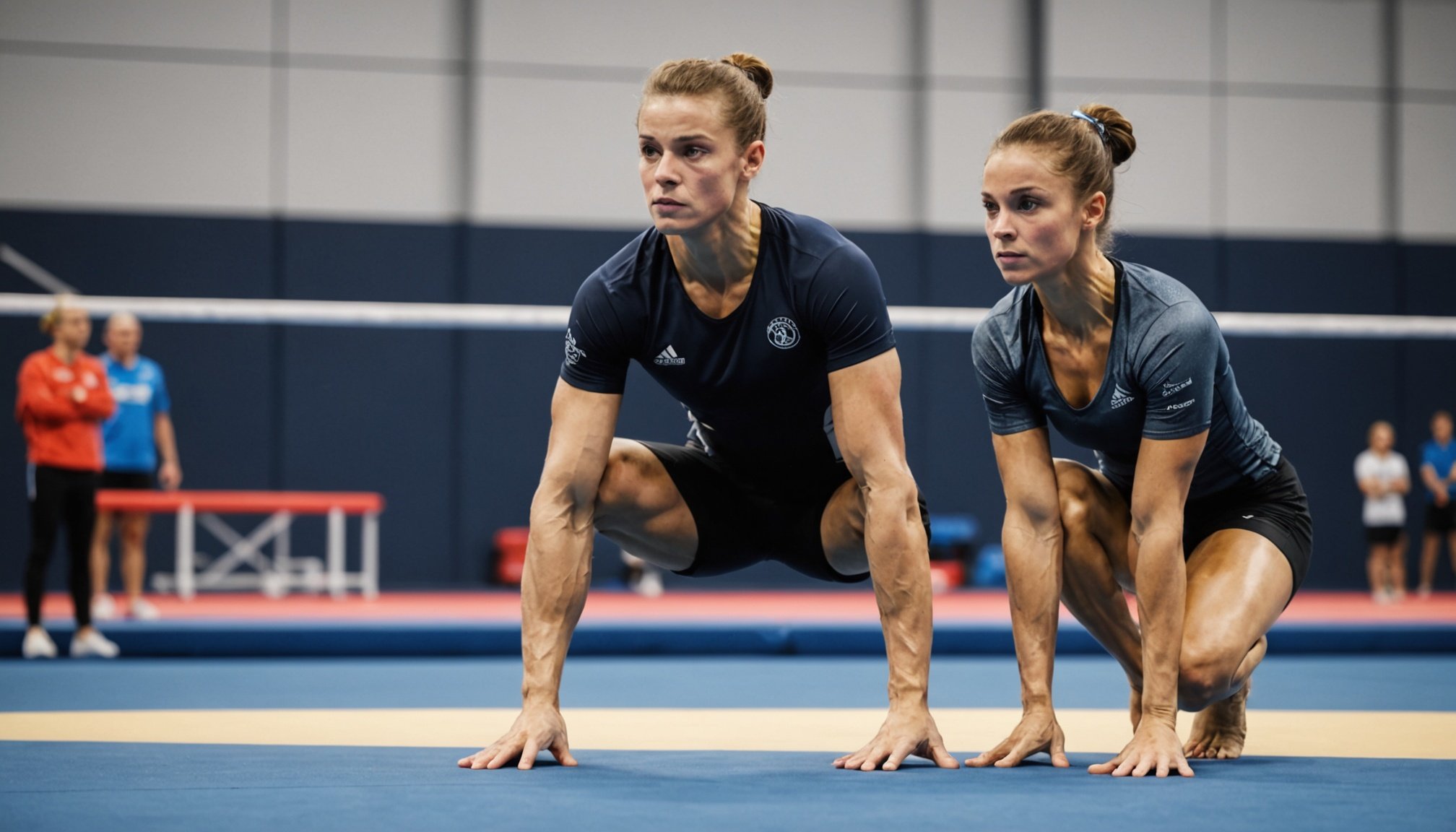Understanding Injury Anxiety in Gymnastics
Injury anxiety is a common concern in gymnastics, affecting both performance and mental health. It is the apprehension or worry stemming from the possibility of getting injured. This anxiety can significantly impact a gymnast’s performance, leading to decreased focus and heightened stress levels. Such feelings are especially prevalent owing to the sport’s physically demanding nature.
Impact on Performance and Mental Health
Gymnasts experiencing injury anxiety often find themselves underperforming. The fear of injury can hinder their ability to execute complex routines with precision. Additionally, the constant worry impacts mental health, leading to stress, lack of motivation, and even burnout.
Also to discover : Turbocharge young sprinters: effective techniques to enhance speed in junior athletes
Indicators Across Experience Levels
In young athletes, injury anxiety may manifest as avoidance of certain skills or events. Experienced gymnasts might exhibit signs such as hyper-awareness during routines or hesitancy in executing familiar skills. Recognising these indicators early allows for timely intervention, fostering a more supportive environment.
Understanding the nuances of injury anxiety in gymnastics is crucial. It aids in addressing these emotions proactively, thereby enhancing both physical performance and emotional well-being. The ability to distinguish between normal nerves and debilitating injury anxiety can make a significant difference in an athlete’s career.
In parallel : Turbocharge young sprinters: effective techniques to enhance speed in junior athletes
Proven Techniques for Overcoming Injury Anxiety
In the high-pressure world of gymnastics, mastering coping strategies and mental conditioning techniques is crucial for overcoming injury anxiety. A range of evidence-based techniques can help athletes navigate the psychological barriers linked with fear of injury.
Cognitive Behavioral Approaches
Cognitive-behavioral strategies are effective in managing injury anxiety by helping gymnasts reframe negative thoughts. Cognitive restructuring involves identifying and altering irrational beliefs that trigger anxiety. In practical terms, this means recognising thoughts like “I will get injured” and replacing them with more balanced perspectives. Developing personalized coping strategies is equally important, allowing athletes to prepare mentally for potential stressors.
Visualization Techniques
Visualization is a powerful tool for enhancing confidence and reducing anxiety. By mentally rehearsing routines without fear, gymnasts can bolster their self-assurance and diminish anxious tendencies. Practical visualization exercises include visualising successful performances and mentally walking through routines, which not only boost confidence but also activate motor learning, leading to improved gymnastics performance.
Mindfulness and Relaxation Exercises
Incorporating mindfulness practices in daily training aids in managing stress and anxiety. Techniques like focused breathing and progressive muscle relaxation enable gymnasts to shift their focus to the present moment, alleviating performance-related stress. These simple relaxation techniques prove beneficial when performed before competitions, allowing athletes to establish a calm mental state conducive to peak performance.
Personal Anecdotes and Case Studies
Injury anxiety is not just an abstract concept; it resonates deeply in the world of elite gymnastics. Personal stories from athlete experiences offer tangible insights into overcoming this mental hurdle. Take Jamie, a young gymnast, who faced debilitating injury anxiety after a major fall. Her journey back to the mat involved using coping strategies and mental conditioning to rebuild confidence. Through structured visualization techniques, Jamie learned to mentally rehearse routines, transforming fear into competence.
Tom, an experienced gymnast, battled with injury anxiety manifested as hesitancy and hyper-awareness. With the support of his coach, he engaged in a mix of cognitive behavioral approaches and relaxation techniques, which enabled him to focus on performance rather than potential mishaps. These personal narratives underline the importance of a supportive environment – vital for mitigating anxiety and fostering athletic growth.
Coaches and trainers play a critical role in these journeys. By providing empathy and expertise, they help athletes like Jamie and Tom navigate the complex maze of injury anxiety. These shared stories not only provide practical examples but also inspire gymnasts to view injury anxiety as a conquerable challenge, paving the way for resilience and success in the sport.
Expert Advice on Injury Management
Navigating the landscape of injury anxiety in gymnastics involves leveraging insights from field experts. Sports psychology professionals play a pivotal role in addressing the psychological complexities gymnasts face, offering tailored strategies to enhance mental well-being. They recommend practices such as cognitive restructuring and relaxation techniques to help athletes manage stress effectively, underlining the importance of a balanced mental approach to training.
Insights from Sports Psychologists
Engaging with sports psychologists can provide invaluable support for gymnasts dealing with anxiety. Experts advocate for recognizing individual triggers and using specific interventions to mitigate these stressors. They suggest structured therapy sessions that focus on positive reinforcement and goal-setting to bolster mental resilience.
Integrating Physical Recovery with Mental Strength
Physical rehabilitation should go hand-in-hand with mental fortitude. Building this connection involves acknowledging the role of psychological recovery during physical therapy. Gymnasts benefit from setting achievable targets and maintaining a positive outlook, which aids in the continuity of training during an injury layoff. Experts recommend mental conditioning routines alongside rehab exercises to sustain motivation.
Building a Support System
A robust support system is crucial for athletes managing anxiety. Effective communication with coaches and teammates fosters a nurturing atmosphere, encouraging gymnasts to express concerns openly. Implementing strategies that involve collaborative goal-setting and feedback can aid in creating a more supportive environment, integral to any gymnast’s recovery journey.
Practical Exercises for Every Gymnast
Balancing practical techniques with anxiety management is essential for gymnasts tackling injury anxiety. Identifying effective methods tailored to individual needs can empower athletes to elevate their performance while maintaining mental calm.
Pre-Performance Routines
Crafting pre-performance routines is vital for enhancing focus and alleviating anxiety. Incorporating exercises like deep breathing aids relaxation, fostering a state of mental readiness. Visualization is also crucial; mentally practicing routines can enhance confidence, ensuring athletes walk into competitions with reinforced composure.
Accountability Practices
Personal accountability boosts both skill development and emotional resilience. Setting clear goals and keeping a journal helps athletes reflect on their experiences and emotions, creating a growth framework. Journaling acts as a personal support system, offering insights into progress and emotional patterns, ultimately aiding in managing anxiety.
Supportive Community Engagement
Engaging with a supportive community provides additional layers of encouragement and understanding. Participation in workshops and peer support groups centred on mental resilience creates an enriched atmosphere for learning and sharing experiences. Connecting with fellow athletes allows gymnasts to navigate challenges together, reinforcing a cooperative approach to overcoming injury anxiety.

